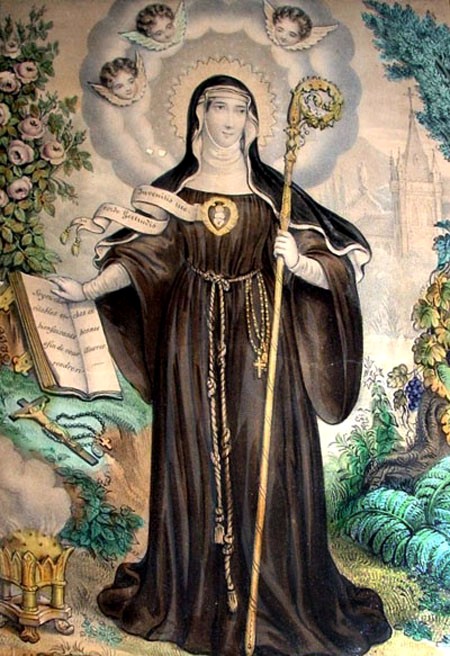A great mystic and scholar

Saint Gertrude the Great, a 13th-century German Benedictine nun, mystic, and theologian, holds a special place in the history of Christian spirituality. Born on January 6, 1256, in Eisleben, now modern-day Germany, Gertrude was one of the most influential figures of medieval mysticism.
She is renowned for her deep theological insight, vivid mystical visions, and profound devotion to the humanity of Christ, especially His Sacred Heart. Although she was never formally canonised by the Roman Catholic Church, Pope Benedict XIV conferred on her the title “the Great,” a designation shared with very few women in the history of the Church.
Gertrude was sent to the Benedictine monastery at Helfta, near Eisleben, at the age of five. It is uncertain whether she was an orphan or placed there by her parents for educational and religious formation. The monastery was led by Abbess Gertrude of Hackeborn and was known for its emphasis on learning and spiritual development.
Young Gertrude received an exceptional education in Latin, literature, philosophy, and theology. The intellectual rigor of her education would later become evident in her writings, which reflect both scholastic clarity and mystical depth.
Despite her rigorous intellectual life, Gertrude initially showed little interest in a personal relationship with God. Her early years in the convent were marked more by academic achievement than by spiritual fervour. However, at the age of 25 she experienced a profound conversion.
In 1281, Gertrude had a vision of Christ that radically altered the course of her life. In her own writings, she describes Christ appearing to her as a young man who gently invited her into a more intimate union with Him. This experience awakened in her a passionate love for God and a deep commitment to prayer, humility, and contemplation.
After this vision, Gertrude withdrew from secular studies and devoted herself entirely to spiritual writing, mystical prayer, and acts of penance. Her inner transformation was accompanied by numerous mystical experiences and revelations, many of which she recorded in her writings. Chief among these texts is her Legatus Divinae Pietatis (The Herald of Divine Love), a spiritual autobiography and theological reflection that details her visions, dialogues with Christ, and insights into divine love.
Gertrude was among the first to articulate a strong devotion to the Sacred Heart of Jesus, a theme that would later become central in Catholic spirituality, particularly through Saint Margaret Mary Alacoque in the 17th century. In her visions, she often saw Christ’s heart as the source of divine mercy and love, a refuge for sinners and a furnace of charity.
This devotion was not simply emotional; it had a strong theological grounding. Gertrude saw the Sacred Heart as a symbol of the Incarnation — Christ’s complete union with humanity — and a sign of His boundless compassion. Her writings helped shape Christian understanding of God’s tender love and the accessibility of divine grace.
Gertrude’s writings are significant for their balance of mystical experience and theological depth. She interpreted her visions not merely as personal experiences but as revelations meant for the edification of the Church. Her understanding of union with Christ emphasised both emotional intimacy and doctrinal soundness. She spoke of the soul as the bride of Christ, echoing the bridal mysticism found in the Song of Songs and other Christian mystics.
She deeply loved the liturgy and often wrote prayers designed to be used during the Divine Office and the Mass. These prayers, filled with rich theological language and poetic beauty, highlighted themes of gratitude, humility, and divine mercy.
Though relatively unknown outside the Helfta convent during her lifetime, Gertrude’s influence grew steadily after her death at the age of forty-five or forty-six in 1302. Her writings were widely circulated in the late Middle Ages and early modern period. She became especially popular in German-speaking regions and among those devoted to the Sacred Heart.
In the 17th and 18th centuries, her works gained renewed attention during the rise of the Catholic Counter-Reformation and the flourishing of baroque spirituality. Many later mystics and theologians, including Saint Francis de Sales and Saint Margaret Mary Alacoque, regarded Gertrude as a spiritual forerunner.
Saint Gertrude the Great stands as a radiant figure in Christian mysticism, a bridge between scholastic theology and the heartfelt devotion of the mystics. Her legacy is one of deep personal intimacy with Christ, intellectual brilliance, and enduring spiritual insight.
By placing love at the centre of her theology and emphasising the tenderness of the Sacred Heart, she helped shape a vision of God not as a distant judge but as an affectionate and approachable Saviour.
Her feast day is celebrated on November 16 and is especially revered by Benedictines and those devoted to the Sacred Heart. She is patron saint of travellers, widows, and the mentally ill.
We encourage you to share and use this material on your own website. However, when using materials from Majellan Media’s website, please include the following in your citation: Sourced from www.majellan.media
